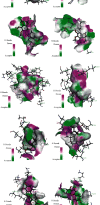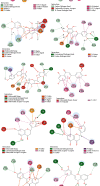Molecular Mechanism of the Effect of Zhizhu Pill on Gastroesophageal Reflux Disease Based on Network Pharmacology and Molecular Docking
- PMID: 35646148
- PMCID: PMC9135531
- DOI: 10.1155/2022/2996865
Molecular Mechanism of the Effect of Zhizhu Pill on Gastroesophageal Reflux Disease Based on Network Pharmacology and Molecular Docking
Abstract
Background: To investigate the pharmacological mechanism of Zhizhu pill (ZZP) against gastroesophageal reflux disease (GERD), network pharmacology in combination with molecular docking was applied in this study.
Methods: Active compounds of ZZP and target genes related to GERD were identified through public databases. Subsequently, the obtained data were used as a basis for further network pharmacological analysis to explore the potential key active compounds, core targets, and biological processes involved in ZZP against GERD. Finally, the results predicted by network pharmacology were validated by molecular docking.
Results: Twenty active components of ZZP were identified to act on 59 targets related to GERD. Enrichment analysis revealed that multiple biological processes including response to oxygen levels, response to oxidative stress, and response to reactive oxygen species were involved in the GERD ZZP treatment with ZZP. ZZP had an impact on the prognosis of GERD mainly through the HIF-1 signaling pathway, PI3K-Akt signaling pathway, and pathways in cancer. Further analysis identified the key components and core targets of ZZP against GERD, of which nobiletin, didymin, luteolin, and naringenin were key components, and PPARG, MMP9, JUN, TP53, PTGS2, EGFR, MAPK3, CASP3, AKT1, and VEGFA were the core targets. Molecular docking verified the stable bonds formed between the key components and the core targets.
Conclusions: The results of this study predict that the therapeutic effects of ZZP in GERD are mediated at least in part via PPARG, MMP9, JUN, TP53, PTGS2, EGFR, MAPK3, CASP3, AKT1, and VEGFA. These results may be useful in providing an experimental basis and new ideas for further research on ZZP in GERD.
Copyright © 2022 Jinke Huang et al.
Conflict of interest statement
The authors declare that there are no conflicts of interest.
Figures







Similar articles
-
Molecular Targets and Mechanisms of Scutellariae radix-Coptidis rhizoma Drug Pair for the Treatment of Ulcerative Colitis Based on Network Pharmacology and Molecular Docking.Evid Based Complement Alternat Med. 2021 Jun 4;2021:9929093. doi: 10.1155/2021/9929093. eCollection 2021. Evid Based Complement Alternat Med. 2021. PMID: 34149863 Free PMC article.
-
Exploring the pharmacological components and effective mechanism of Mori Folium against periodontitis using network pharmacology and molecular docking.Arch Oral Biol. 2022 Jul;139:105391. doi: 10.1016/j.archoralbio.2022.105391. Epub 2022 Mar 21. Arch Oral Biol. 2022. PMID: 35430443
-
Investigating the Mechanisms of Pollen Typhae in the Treatment of Diabetic Retinopathy Based on Network Pharmacology and Molecular Docking.Evid Based Complement Alternat Med. 2022 Jan 3;2022:5728408. doi: 10.1155/2022/5728408. eCollection 2022. Evid Based Complement Alternat Med. 2022. PMID: 35024051 Free PMC article.
-
Study on Mechanism of Jiawei Chaiqin Wendan Decoction in Treatment of Vestibular Migraine Based on Network Pharmacology and Molecular Docking Technology.Evid Based Complement Alternat Med. 2021 Oct 31;2021:5528403. doi: 10.1155/2021/5528403. eCollection 2021. Evid Based Complement Alternat Med. 2021. PMID: 34754315 Free PMC article.
-
Naringenin as a natural immunomodulator against T cell-mediated autoimmune diseases: literature review and network-based pharmacology study.Crit Rev Food Sci Nutr. 2023;63(32):11026-11043. doi: 10.1080/10408398.2022.2092054. Epub 2022 Jul 1. Crit Rev Food Sci Nutr. 2023. PMID: 35776085 Review.
Cited by
-
Prediction and analysis of genetic effect in idiopathic pulmonary fibrosis and gastroesophageal reflux disease.IET Syst Biol. 2023 Dec;17(6):352-365. doi: 10.1049/syb2.12081. Epub 2023 Oct 31. IET Syst Biol. 2023. PMID: 37907428 Free PMC article.
-
Multidimensional mechanisms and therapies underlying gastroesophageal reflux disease: focus on immunity, signaling pathways, and the microbiota-gut-brain axis.Front Immunol. 2025 Jul 18;16:1629944. doi: 10.3389/fimmu.2025.1629944. eCollection 2025. Front Immunol. 2025. PMID: 40755761 Free PMC article. Review.
-
Exploring the components and mechanisms of Shen-qi-wang-mo granule in the treatment of retinal vein occlusion by UPLC-Triple TOF MS/MS and network pharmacology.Sci Rep. 2023 Apr 1;13(1):5330. doi: 10.1038/s41598-023-32472-0. Sci Rep. 2023. PMID: 37005436 Free PMC article.
-
Hewei Jiangni granule alleviates visceral hypersensitivity of non-erosive reflux diseasestromal interaction molecule 1/transient receptor potential vanilloid subfamily member 1 pathway.J Tradit Chin Med. 2025 Feb;45(1):1-12. doi: 10.19852/j.cnki.jtcm.2025.01.001. J Tradit Chin Med. 2025. PMID: 39957153 Free PMC article.
-
The Potential Mechanism of Alpiniae oxyphyllae Fructus Against Hyperuricemia: An Integration of Network Pharmacology, Molecular Docking, Molecular Dynamics Simulation, and In Vitro Experiments.Nutrients. 2024 Dec 28;17(1):71. doi: 10.3390/nu17010071. Nutrients. 2024. PMID: 39796505 Free PMC article.
References
LinkOut - more resources
Full Text Sources
Research Materials
Miscellaneous

